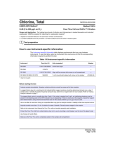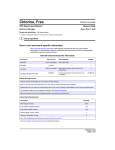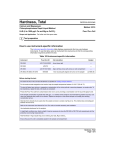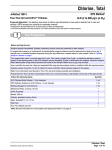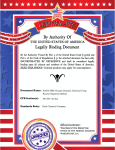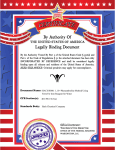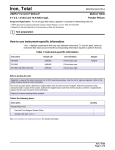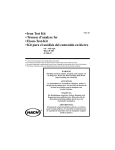Download Manual - Hach Chlorine Reagent Set (Total)
Transcript
Chlorine, Total, 8370 Chlorine, Total DOC316.53.01031 USEPA1 DPD Method2 Method 8370 ULR (2 to 500 µg/L as Cl2) Pour-Thru™ Cell Scope and Application: For detecting trace levels of chlorine and chloramines in clean waters relatively free of color and turbidity; USEPA accepted for reporting for drinking water analysis. 1 USEPA accepted 2 U.S. Patent 5,362,650 Test preparation How to use instrument-specific information The Instrument-specific information table displays requirements that may vary between instruments. To use this table, select an instrument then read across to find the corresponding information required to perform this test. Table 120 Instrument-specific information Instrument DR 6000 Pour-thru Kit Cell orientation Adapter LQV175.99.20002 Arrow faces right — DR 5000 LZV479 — — DR 3900 LQV157.99.10002 Align cell flow arrows with arrows on cell compartment — 5940400 1-inch (round) path aligned with arrow on the adapter LZV585 (B) DR 3800, DR 2800, DR 2700 Before starting the test: Analyze samples immediately. Samples containing chlorine cannot be preserved for later analysis. A reagent blank value for a combined lot of indicator/buffer reagent solutions should be determined at least once a day. If sample color or turbidity fluctuates frequently during the day, determine a reagent blank for each sample. Ampules contain more than 1.0 mL of solution for ease of transfer. Discard excess reagent in the ampule. Refer to the instrument User Manual for Pour-Thru cell and module assembly and installation. Protect the Pour-Thru Cell from contamination when not in use by inverting a small beaker over the top of the glass funnel. Refer to Treating analysis labware. Collect the following items: Description Quantity ULR Chlorine Buffer Solution, 1.5-mL ampules 1 mL DPD Indicator Solution for ULR Chlorine, 1.5-mL ampules 1 mL Blanking Reagent for ULR Chlorine 1 mL Beaker, 250 mL 1 Cylinder, graduated mixing, 50-mL. 1 Pipet, TenSette®, 0.1 to 1.0 mL 1 Pipet Tips for TenSette Pipet 2 Chlorine, Total Page 1 of 10 Chlorine, Total Collect the following items: (continued) Description Quantity Pour-Thru Module and cell (See Instrument Specific Information) 1 Ampule Breaker 1 See Consumables and Replacement Items for reorder information. DPD method for Pour-Thru Cell Stored Programs 86 Chlorine Total ULR Zero Start 1. Select the test. Insert an adapter if required (Instrumentspecific information). 5. Open one ULR Chlorine Buffer Solution Ampule. 2. Pour at least 50 mL of sample into the Pour-Thru Cell. 6. Using a TenSette® Pipet and a clean tip, transfer 1.0 mL of buffer from the ampule to a clean, treated 50-mL graduated mixing cylinder. 3. When the flow stops, start the instrument timer. A three-minute reaction period will begin. This time allows turbidity or solids to settle and ensures a stable reading. 7. Open one ampule of DPD Indicator Solution for Ultra Low Range Chlorine. 4. When the timer expires, ZERO the instrument. The display will show: 0 µg/L 8. Use a TenSette Pipet and a clean tip to transfer 1.0 mL of indicator from the ampule to the graduated mixing cylinder. Swirl to mix. Proceed to step 9 within one minute. Chlorine, Total Page 2 of 10 Chlorine, Total DPD method for Pour-Thru Cell (continued) Read 9. Prepared Sample: Avoiding extra agitation, carefully fill the cylinder to the 50-mL mark with sample. Stopper the cylinder. Gently invert it twice to mix. 10. Start the instrument timer. A three-minute reaction time will begin. Measure the reacted sample 3–4 minutes after mixing the sample and reagents. If less than three minutes elapses, the reaction with chloramines may be incomplete. A reading after four minutes may result in higher reagent blank values. 11. Pour the contents of the graduated mixing cylinder into the Pour-Thru cell. 12. When the timer expires, READ the results in µg/L chlorine. If a dechlorinating agent (e.g. sulfite or sulfur dioxide) is present, the sample result (corrected for the reagent blank) will read “0” or a slightly negative value. 13. Flush the Pour-Thru Cell with at least 50-mL of deionized water immediately after use. Chlorine, Total Page 3 of 10 Chlorine, Total Determining the reagent blank value Stored Programs 86 Chlorine Total ULR Start 1. Select the test. Make sure that the reagent blank setting is off. 2. Install the Pour-Thru module. See the user manual for information. Flush the Pour-Thru cell with 50 mL of deionized water. 5. Access the general timer and set it for five minutes. Start the timer. 6. After the timer expires, open one ampule of ULR Chlorine Buffer Solution. Chlorine, Total Page 4 of 10 3. Collect about 100 mL of deionized or tap water in a clean, 250-mL beaker. 4. Use a TenSette® Pipet to add 1.0 mL of Blanking Reagent to the beaker. Swirl several times to mix. The Blanking Reagent removes chlorine and chloramines from the water. Note: This solution will be used in Step 10. 7. Use a TenSette Pipet and a clean tip to transfer 1.0 mL buffer from the ampule to a clean 50 mL mixing graduated cylinder. 8. Open one ampule of DPD Indicator Solution for Ultra Low Range Chlorine. Chlorine, Total Determining the reagent blank value (continued) 9. Use a TenSette Pipet and a clean tip to transfer 1.0 mL of indicator from the ampule to the cylinder. Swirl to mix the reagents. Proceed to step 10 within one minute. 10. Fill the cylinder to the 50-mL mark with dechlorinated water from step 4. Cap and invert twice to mix. Save the remaining water for step 12. Zero Read 13. When the flow stops, ZERO the instrument. The display will show: 0 µg/L Cl2. 14. When the timer expires, pour the contents of the cylinder into the Pour-Thru Cell. READ the results in µg/L chlorine. 11. Start the instrument timer. A three-minute reaction time will begin. 15. Use this value to correct the sample result obtained in this procedure. See the user manual for details on saving the reagent blank value. 12. During the reaction period, flush the Pour-Thru Cell with the remainder of original dechlorinated water from step 10. 16. Flush the Pour-Thru Cell with at least 50-mL of deionized water immediately after use. Interferences Table 121 Interfering substances and levels Interfering substance Interference levels and treatments Bromine, Br2 Interferes at all levels Chlorine Dioxide, ClO2 Interferes at all levels Chloramines, organic May interfere Copper, Cu2+ Greater than 1000 µg/L Iodine, I2 Interferes at all levels. Iron (Fe3+) Greater than 1000 µg/L Chlorine, Total Page 5 of 10 Chlorine, Total Table 121 Interfering substances and levels (continued) Interfering substance Manganese, oxidized (Mn4+, Mn7+) or Chromium, oxidized (Cr6+) Interference levels and treatments 1. Adjust sample pH to 6 –7 with 1.000 N Sulfuric Acid1. 2. 3. Add 9 drops Potassium Iodide (30 g/L)1 to an 80-mL sample. Mix and wait 1 minute. 4. 5. 6. Add 9 drops Sodium Arsenite1, 2 (5 g/L) and mix. Analyze the treated sample as described in the procedure above. Subtract the result of this test from the original analysis to obtain the correct concentration. Nitrite, NO2– (uncommon in clean waters) Ozone Interferes at all levels Peroxides May interfere Extreme sample pH or highly buffered samples Adjust to pH 6–7 mg/L nitrite Apparent µg/L chlorine 2.0 mg/L 3 µg/L 5.0 mg/L 5 µg/L 10.0 mg/L 7 µg/L 15.0 mg/L 16 µg/L 20.0 mg/L 18 µg/L 1 See Optional reagents and apparatus. 2 Samples treated with sodium arsenite for interferences will be hazardous waste as regulated by the Federal RCRA for arsenic (D004). Refer to the current MSDS for safe handling and disposal instructions. Sample collection, storage and preservation • Analyze samples for chlorine immediately after collection. Many factors, including reactant concentrations, sunlight, pH, temperature and salinity influence decomposition of chlorine in water. • Avoid plastic containers since these may have a large chlorine demand. • Pretreat glass sample containers to remove any chlorine demand by soaking in a dilute bleach solution (1 mL commercial bleach to 1 liter of deionized water) for at least 1 hour. Rinse thoroughly with deionized or distilled water. If sample containers are rinsed thoroughly with deionized or distilled water after use, only occasional pre-treatment is necessary. • A common error in testing for chlorine is failure to obtain a representative sample. If sampling from a tap, let the water flow for at least 5 minutes to ensure a representative sample. Let the container overflow with the sample several times, then cap the sample containers so there is no headspace (air) above the sample. Perform the chlorine analysis immediately. Treating analysis labware Glassware used in this test must be chlorine demand-free. Fill the 100-mL mixing cylinder and sample container with a dilute solution of chlorine bleach prepared by adding 1 mL of commercial bleach to 1 liter of water. Soak in this solution at least one hour. After soaking, rinse thoroughly with deionized water and allow to dry before use. Treat the Pour-Thru Cell similarly with dilute bleach and let stand for several minutes. Rinse several times with deionized water. Chlorine, Total Page 6 of 10 Chlorine, Total Cleaning the Pour-Thru cell The Pour-Thru Cell may accumulate a buildup of colored reaction products, especially if the reacted solutions are allowed to remain in the cell for long periods after measurement. Remove the buildup by rinsing the cell with 5.25 N Sulfuric Acid followed by several rinsings with deionized water. Accuracy check Required for accuracy check: • Low Range Chlorine PourRite® Ampule Standard Solution, 25 to 30-mg/L (25,000 to 30,000 µg/L) Cl2 • TenSette® Pipet and tips • Ampule Breaker Standard additions method (sample spike) 1. After reading test results, leave the sample cell (unspiked sample) in the instrument. 2. Select Options>More>Standard Additions from the instrument menu. 3. Default values for standard concentration, sample volume and spike volumes can be accepted or edited. Enter the chlorine concentration from the ampule package. After values are accepted, the unspiked sample reading will appear in the top row. See the user manual for more information. 4. Open a Low Range Chlorine Voluette Ampule Standard Solution, 25 to 30-mg/L (25,000 to 30,000 µg/L) Cl2. 5. Prepare three sample spikes. Use the TenSette Pipet to add 0.1, 0.2 and 0.3 mL of standard to three 50-mL samples, respectively. Swirl gently to mix. 6. Analyze each sample spike as described in the procedure above, starting with the 0.1 mL sample spike. Accept each standard additions reading by pressing READ. Each addition should reflect approximately 100% recovery. 7. After completing the sequence, press GRAPH to view the best-fit line through the standard additions data points, accounting for the matrix interferences. Press IDEAL LINE to view the relationship between the sample spikes and the “Ideal Line” of 100% recovery. Chlorine, Total Page 7 of 10 Chlorine, Total Method performance Program 86 Standard 295 µg/L Cl2 Precision 95% Confidence Limits of Distribution 290–300 µg/L Cl2 Sensitivity Concentration change per 0.010 Abs change Point of curve Concentration Entire range 17 µg/L Cl2 Summary of method This method is designed for clean water, low in color and turbidity. The main applications include monitoring for trace chlorine break-through of activated carbon beds and feedwater to reverse osmosis membranes or ion-exchange resins. Several modifications to the normal DPD chlorine method are necessary to measure trace levels of chlorine. The Pour-Thru Cell must be used in the spectrophotometer. Liquid reagents are also required. The reproducible optics of the Pour-Thru Cell give more stable readings than is possible with movable sample cells, resulting in more stable measurements. The reagents are packaged in ampules and sealed under argon gas to ensure stability. Use of liquid reagents eliminates any slight turbidity that might be caused by using powdered reagents. Due to the possible oxidation of the reagents (which could give a positive chlorine reading in the blank), a reagent blank must be determined at least once a day for each lot of reagent used. This reagent blank value is subtracted from the sample result and the corrected value is the actual chlorine concentration. Test results are measured at 515 nm. Chlorine, Total Page 8 of 10 Chlorine, Total Consumables and Replacement Items Required Reagents Description Quantity/Test Unit ULR Chlorine Buffer Solution, 1.5-mL ampules 1 mL 20/pkg 2493120 DPD Indicator Solution for ULR Chlorine, 1.5-mL ampules 1 mL 20/pkg 2493220 Blanking Reagent for ULR Chlorine 1 mL 29 mL 2493023 ULR Chlorine Reagent Set (approximately 20 tests), includes: Catalog number 2563000 Required Apparatus Description Quantity Unit Catalog number PourRite® Ampule Breaker 1 each 2484600 Beaker, 250-mL 1 each 50046H Cylinder, graduated mixing, 50-mL 1 each 189641 Pipet, TenSette®, 0.1 to 1.0 mL 1 each 1970001 Pipet Tips, for TenSette Pipet 1970001 2 50/pkg 2185696 Unit Catalog number 20/pkg 2630020 Recommended Standards Description Chlorine Standard Solution, PourRite® Ampule, 25–30 mg/L, 2-mL Optional reagents and apparatus Description Unit Potassium Iodide, 30 g/L 100 mL 34332 Sodium Arsenite, 5 g/L 100 mL 104732 127032 Sulfuric Acid, 1 N 100 mL Sulfuric Acid, 5.25 N 1000 mL 244953 pH Paper, 0 - 14 pH range 100/pkg 2601300 Pipet Tips, for TenSette Pipet 19700011 1000/pkg 2185628 each 2196800 20/pkg 1426820 16/pkg 1426810 Voluette Ampule breaker 10 mL Chlorine Standard Solution, 2-mL PourRite® Ampules, 50–75 mg/L Chlorine Standard Solution, 10-mL 1 Catalog number Voluette® ampules, 50–75 mg/L other sizes are available Chlorine, Total Page 9 of 10 FOR TECHNICAL ASSISTANCE, PRICE INFORMATION AND ORDERING: In the U.S.A. – Call toll-free 800-227-4224 Outside the U.S.A. – Contact the HACH office or distributor serving you. On the Worldwide Web – www.hach.com; E-mail – [email protected] © Hach Company, 2007, 2010, 2012. All rights reserved. Printed in the U.S.A. HACH COMPANY WORLD HEADQUARTERS Telephone: (970) 669-3050 FAX: (970) 669-2932 Edition 7










